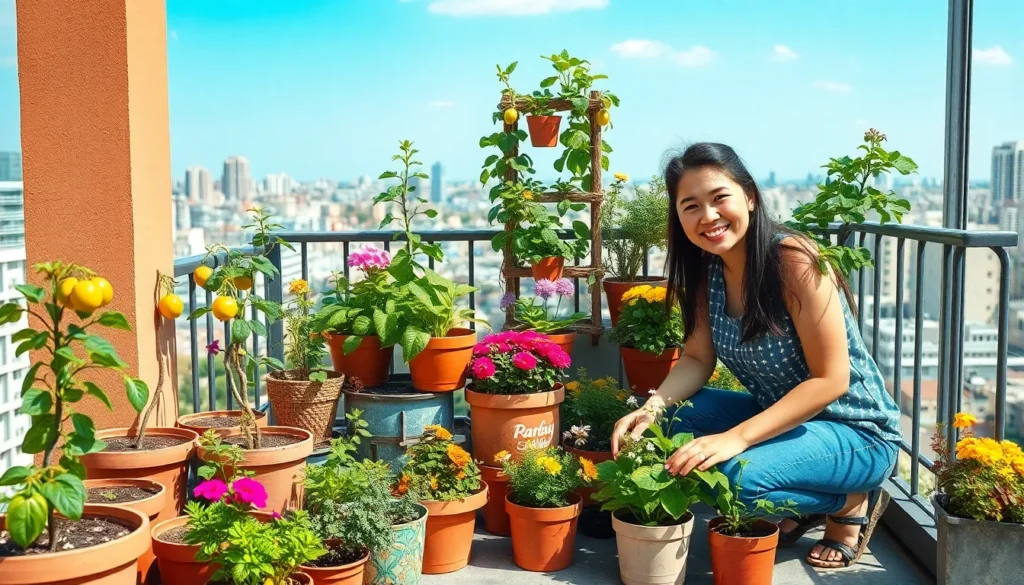Limited space doesn’t mean you can’t create the garden of your dreams. Whether you’re working with a tiny balcony, a compact backyard, or even just a windowsill, we’ve discovered countless ways to transform cramped quarters into thriving green sanctuaries.
Small space gardening has become one of the most rewarding trends in modern horticulture. We’ve seen urban dwellers turn fire escapes into vegetable havens and apartment renters create stunning herb gardens in coffee mugs. The key lies in maximizing every square inch through clever design choices and strategic plant selection.
Ready to revolutionize your small space? We’ll share the proven techniques that help you grow more plants in less space while creating visual impact that rivals expansive gardens. From vertical growing systems to container combinations that pack maximum punch, these small space garden ideas will transform how you think about gardening forever.
Vertical Garden Solutions That Maximize Growing Space
We’ve discovered that growing upward rather than outward transforms limited garden spaces into productive green sanctuaries. Vertical gardening techniques allow us to triple our growing capacity while maintaining the same footprint.
Living Wall Systems and Trellises
Living wall systems create stunning green backdrops while maximizing our planting potential in compact areas. We can install modular pocket planters on blank walls, fences, or balcony railings to grow herbs like basil and oregano alongside trailing plants such as pothos and ivy. These systems typically hold 20-30 plants in a 4×6 foot space compared to just 6-8 plants in traditional ground planters.
Trellis structures support climbing vegetables and flowering vines that would otherwise sprawl across valuable floor space. We recommend installing 6-8 foot trellises for pole beans, peas, and cucumber varieties that can produce 3-5 pounds of vegetables per square foot. Wire mesh panels, bamboo frames, and wooden lattice work equally well for supporting climbing plants while adding architectural interest to our small gardens.
DIY pocket gardens made from recycled materials offer budget friendly vertical growing answers. We can repurpose shoe organizers, pallets, or plastic bottles to create custom planting walls that accommodate different plant sizes and root depths.
Hanging Planters and Suspended Gardens
Overhead hanging systems use unused ceiling and eave spaces to expand our growing area without sacrificing ground level room. We suspend planters at varying heights from 3-7 feet to create layered growing zones for different plant types. Trailing tomatoes, strawberries, and flowering petunias thrive in hanging containers while freeing up surface space below.
Macrame and rope hangers add decorative elements while supporting lightweight containers filled with herbs and small vegetables. We position these suspended gardens near windows or covered patios where plants receive 4-6 hours of daily sunlight. Each hanging planter can accommodate 2-4 plants depending on the container size.
Pulley systems make watering and maintenance easier for suspended gardens positioned at higher elevations. We install simple rope and pulley mechanisms that allow us to lower planters for care and raise them back to optimal growing positions.
Tower Gardens and Stackable Containers
Vertical tower planters concentrate multiple growing levels into minimal floor space while providing excellent drainage and root aeration. We stack 4-6 containers vertically to create towers that accommodate 16-24 plants in just 2 square feet of ground space. These towers work exceptionally well for lettuce, spinach, and herbs that don’t require deep root systems.
Strawberry towers and tiered planters offer specialized vertical answers for berry production in small spaces. We can harvest 15-20 pounds of strawberries from a single tower system compared to 3-5 pounds from traditional ground planted rows. The elevated growing positions also protect berries from soil dwelling pests and make harvesting more comfortable.
Self watering tower systems reduce maintenance while ensuring consistent moisture levels throughout all planting levels. We connect drip irrigation tubes or install reservoir systems that distribute water evenly from top to bottom containers. This automation allows us to maintain productive vertical gardens even during busy periods or short vacations.
Container Gardening Techniques for Limited Areas
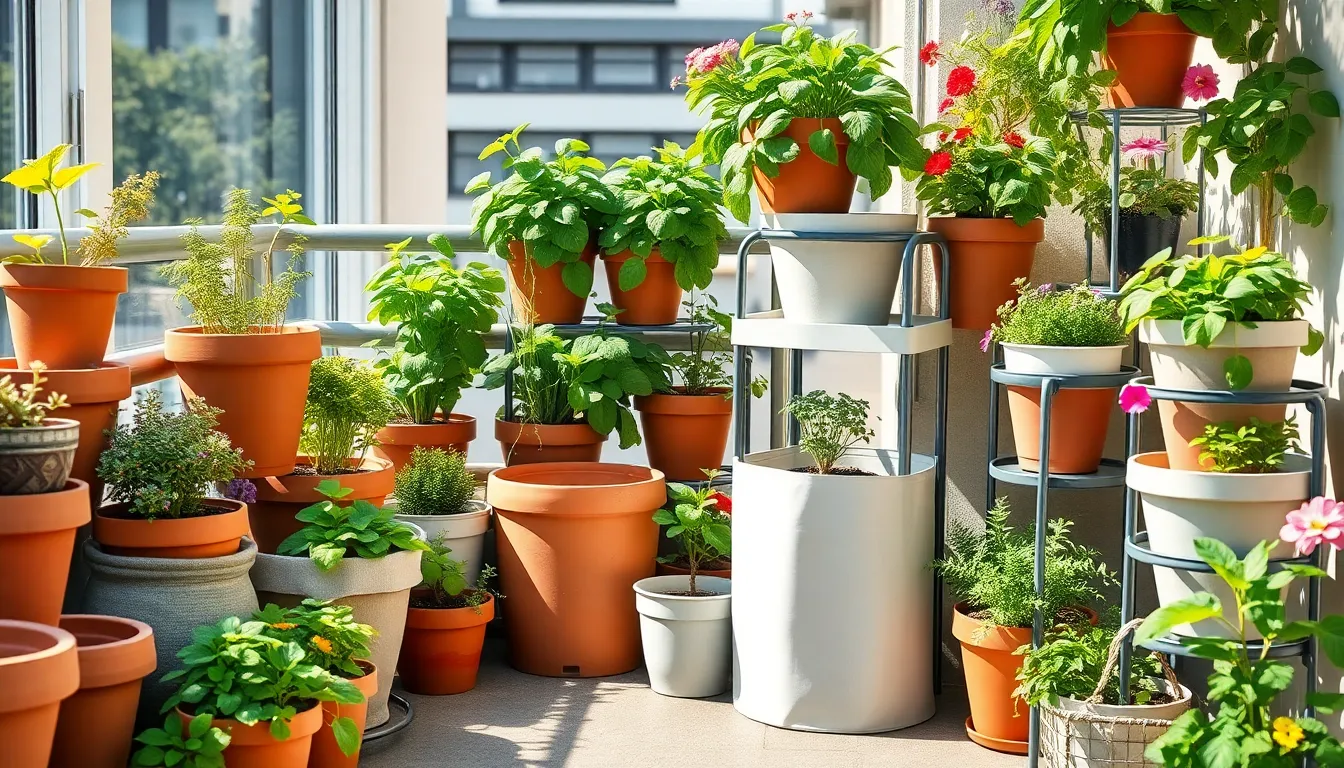
Container gardening enables us to cultivate thriving plants even within the most constrained spaces. This method transforms balconies, patios, and urban environments into productive growing areas using strategic techniques and proper container selection.
Choosing the Right Containers for Small Spaces
Drainage becomes the foundation of successful container gardening, as proper water management prevents root rot and plant failure. We recommend selecting containers with multiple drainage holes, regardless of whether you choose terra cotta, plastic, wooden crates, or repurposed buckets.
Material selection impacts plant health and maintenance requirements in small space gardens. Porous materials like clay allow moisture to escape naturally, requiring more frequent watering but preventing waterlogged soil. Plastic containers retain water longer, making them ideal for herbs like basil, parsley, thyme, mint, and cilantro that prefer consistent moisture.
Size matching ensures optimal plant development within limited growing areas. We match container depth to root requirements, using shallow containers for lettuce and spinach while providing deeper vessels for cherry tomatoes and peppers. Compact or dwarf plant varieties work best in small containers, maximizing productivity without overwhelming the space.
Portable Planter Options for Flexibility
Lightweight resin pots offer exceptional mobility for small space gardeners who need to relocate plants frequently. These containers allow us to chase sunlight throughout the day or protect plants from harsh weather conditions without straining our backs.
Fabric grow bags provide versatile growing answers that adapt to changing garden needs. We find these containers particularly valuable for renters who must relocate their gardens, as they fold flat for storage and weigh significantly less than traditional pots.
Modular planter systems create customizable garden layouts that expand or contract based on available space. These systems enable us to rearrange our growing areas seasonally, optimizing plant placement for maximum productivity and visual appeal.
Multi-Level Container Arrangements
Stacking pots maximizes vertical growing space while maintaining easy access to all plants. We create these arrangements using progressively smaller containers, ensuring adequate sunlight reaches each level while preventing water overflow between tiers.
Tiered plant stands transform flat surfaces into multi-dimensional growing areas that can accommodate significantly more plants. Wall-mounted planters extend this concept vertically, allowing us to use previously unused wall space for herbs and flowers like marigolds, petunias, and pansies.
Companion planting strategies enhance multi-level gardens by combining plants that benefit each other within the same arrangement. We pair marigolds with vegetables like radishes and peppers to deter pests naturally while creating visually appealing color combinations that make our small gardens both productive and beautiful.
Window Box and Windowsill Growing Methods
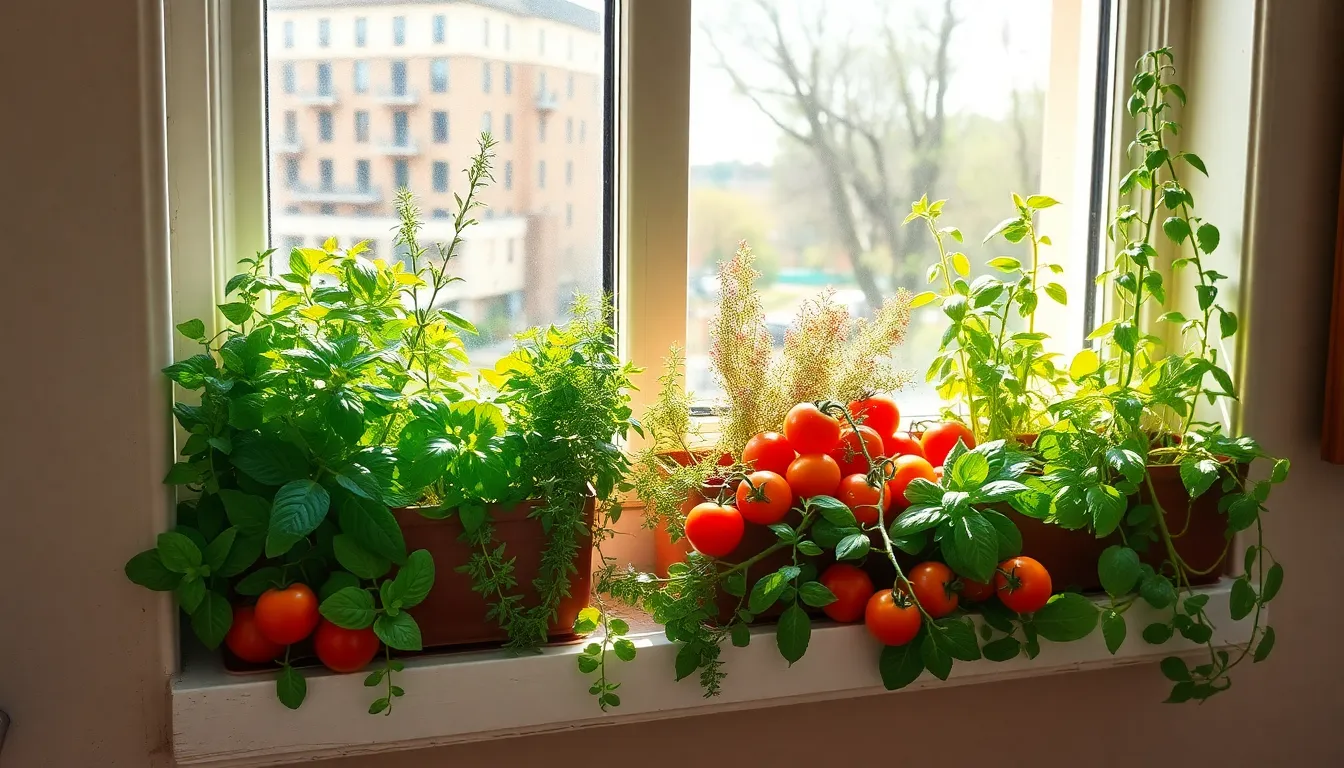
Window boxes and windowsill spaces offer excellent opportunities for growing plants without requiring traditional ground space. These methods work perfectly for apartments, condos, or homes with limited outdoor areas.
Herb Gardens on Window Ledges
Creating herb gardens on window ledges transforms unused spaces into productive growing areas that provide fresh seasonings year-round. We can grow popular herbs like basil, mint, and rosemary directly on ledges, ensuring easy access while cooking. Basil thrives in sunny windows and produces continuous harvests when we pinch flowers regularly. Mint spreads quickly and works well in contained spaces where its aggressive growth stays controlled. Rosemary tolerates various light conditions and provides aromatic foliage that enhances both cooking and air quality.
Indoor window ledges work exceptionally well for tender herbs that need protection from harsh weather. Outdoor ledges accommodate hardier varieties that benefit from natural rainfall and temperature fluctuations. We recommend using shallow containers with proper drainage to prevent root rot while maximizing growing space along window edges.
Compact Vegetable Varieties for Window Boxes
Selecting the right vegetable varieties ensures successful harvests from window box gardens throughout the growing season. Cherry tomatoes and patio tomatoes produce abundant fruit in containers while requiring minimal space compared to full-size varieties. Small pepper varieties like Thai chilies or bell pepper hybrids adapt well to confined growing conditions and provide colorful additions to window displays.
Leafy greens including lettuce, kale, and spinach grow exceptionally well in window boxes because their shallow root systems match container depths perfectly. These vegetables mature quickly and allow for successive plantings that extend harvest periods. We can cut outer leaves while allowing centers to continue growing, maximizing production from limited space.
Root vegetables like radishes and baby carrots also work in deeper window boxes, providing variety to our small space gardens. Bush beans and compact cucumber varieties offer vertical interest while producing substantial yields from single containers.
Indoor Window Garden Setups
Different setup methods allow us to customize window gardens based on available space and growing goals. Hanging planters suspended from ceiling hooks or window frames create multiple growing levels without using floor or ledge space. Self-watering planters maintain consistent moisture levels, reducing daily maintenance while preventing both overwatering and drought stress.
Tiered plant stands maximize vertical space by allowing multiple plants to grow in organized layers near windows. These stands accommodate various container sizes and make it easy to rotate plants for even light exposure. We can arrange shorter plants on lower tiers and taller varieties on upper levels to optimize light distribution.
Window shelves installed across window frames create additional growing surfaces for multiple containers. Adjustable shelving systems adapt to different window sizes and plant heights as gardens develop. We recommend choosing materials that handle moisture well and complement existing window treatments for attractive indoor garden displays.
Balcony and Patio Garden Transformations
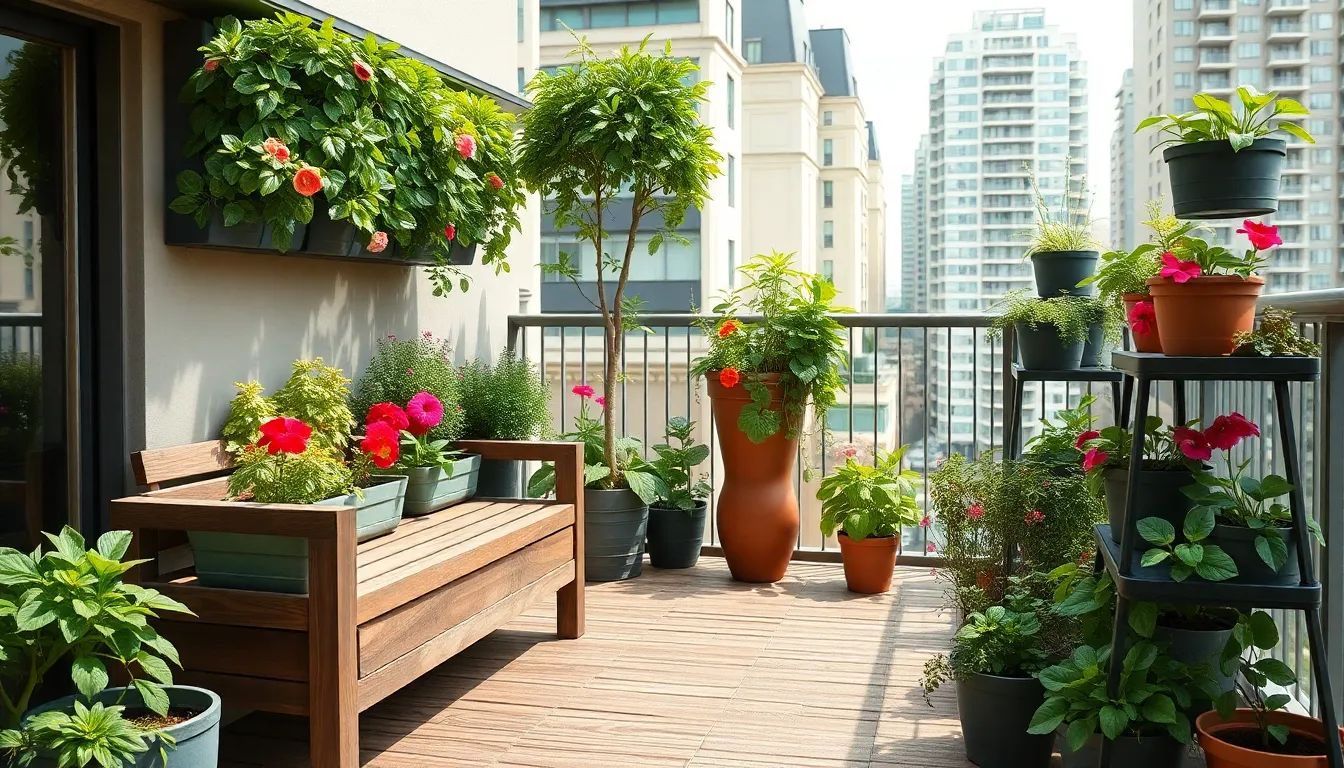
Outdoor living spaces like balconies and patios offer incredible opportunities for creating lush gardens that maximize every square inch. Smart design choices can transform these compact areas into productive green sanctuaries.
Space-Efficient Furniture with Built-In Planters
Multi-functional benches create comfortable seating while housing your favorite plants in integrated planters below the seat. We’ve found that these dual-purpose pieces work especially well for herb gardens where you can easily access your cooking ingredients.
Elevated pot systems attach containers directly to posts, saving valuable floor space while adding vertical interest to your garden design. This approach allows us to display trailing plants like petunias or cherry tomatoes at eye level for easier maintenance.
Storage ottomans with planters provide hidden compartment space for gardening tools while featuring built-in growing areas on top. These versatile pieces work particularly well on smaller patios where every item needs to serve multiple purposes.
Dining tables with integrated gardens feature removable planter inserts that transform meal spaces into growing areas when not in use for entertaining. We recommend using these for fast-growing greens that can be harvested just before dinner parties.
Corner Utilization Strategies
Corner planter boxes make efficient use of typically wasted triangular spaces where two walls or railings meet. These specially designed containers fit snugly into 90-degree angles and provide surprising growing capacity for compact vegetables.
Tiered corner stands create multiple growing levels within a single corner footprint, allowing us to grow different plant heights from ground covers to medium-sized shrubs. Terra cotta arrangements work particularly well for Mediterranean herb combinations.
L-shaped raised beds follow the natural lines of corner spaces while providing deeper soil for root vegetables and larger plants. We’ve successfully grown everything from lettuce to small fruit bushes in these custom-fitted corner answers.
Climbing corner trellises support vertical growing plants like beans, peas, and flowering vines that naturally want to grow upward. Training these plants into corner spaces creates living privacy screens while maximizing our growing potential.
Privacy Screens with Climbing Plants
Arched trellis structures covered in climbing vines create stunning focal points while blocking unwanted views from neighboring properties. These architectural elements work especially well with fast-growing annual vines like morning glories or sweet peas.
Bamboo screen panels provide instant privacy while supporting lightweight climbing plants such as ivy or clematis. We prefer these natural materials because they blend seamlessly with garden aesthetics while remaining budget-friendly.
Wire grid systems offer flexible support for various climbing plants while maintaining an open, airy feeling in compact spaces. These versatile screens can be easily reconfigured as plants grow or seasonal needs change.
Living fence alternatives use dense climbing plants trained on simple support structures to create natural barriers without the bulk of traditional fencing. Evergreen climbing varieties like English ivy provide year-round screening in most climates.
Indoor Micro-Garden Systems
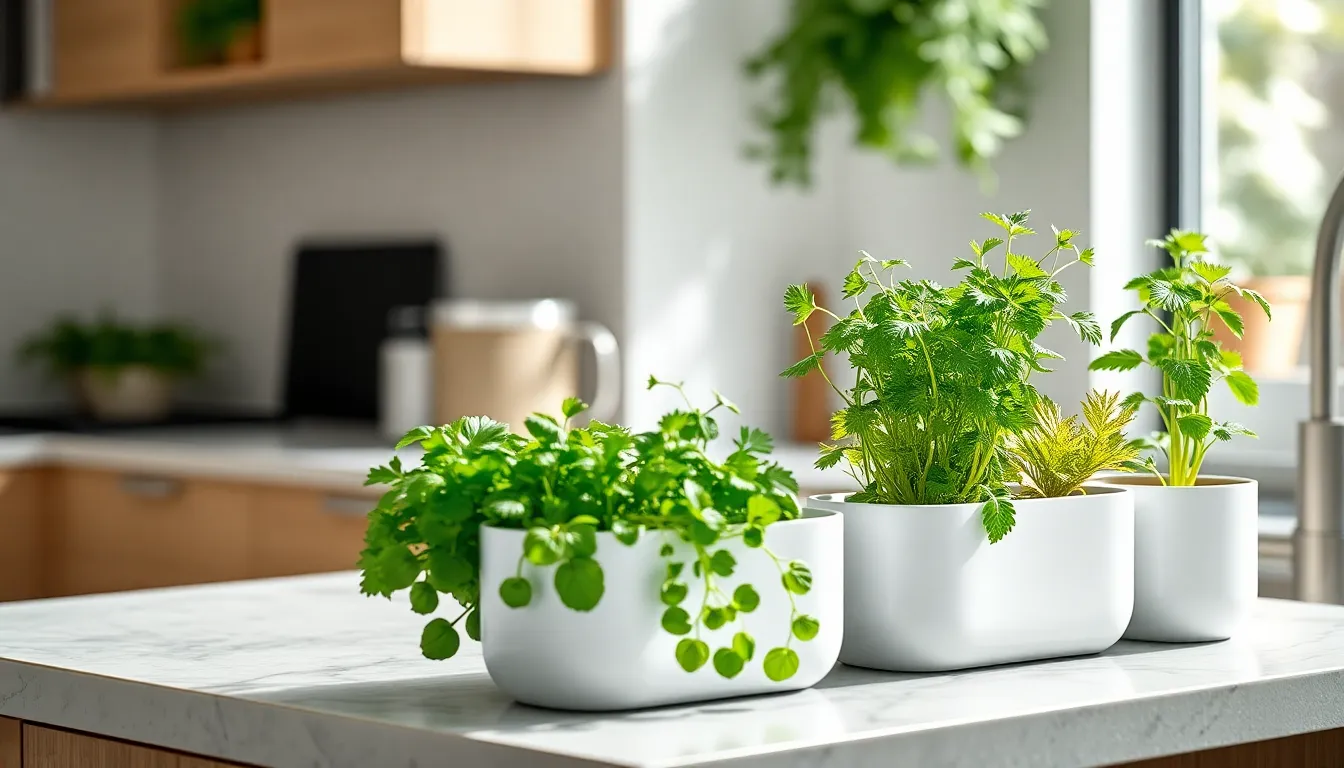
We can bring our gardening passion indoors with compact systems that fit perfectly in apartments, condos, or homes with limited outdoor access.
Countertop Herb Gardens
Compact systems transform our kitchen countertops into productive herb growing stations that provide fresh ingredients year round. Self watering planters eliminate the guesswork from daily care while hydroponic herb kits deliver faster growth rates than traditional soil methods. Popular countertop models accommodate 6 to 12 herb varieties in footprints smaller than a coffee maker.
Automated systems include built in timers and water level indicators that make herb cultivation nearly foolproof for beginners. Fresh basil, parsley, cilantro, and chives grow within arm’s reach of our cooking areas, reducing grocery bills while improving meal flavors. Many countertop gardens feature sleek designs that complement modern kitchen aesthetics rather than cluttering valuable workspace.
Hydroponic Systems for Small Apartments
Hydroponic systems use nutrient rich answers rather than soil, making them ideal for limited space environments where traditional gardening isn’t practical. These soilless growing methods eliminate mess while delivering superior plant nutrition that accelerates growth rates by up to 30% compared to conventional gardening. Tower hydroponic units maximize vertical space by stacking multiple growing chambers in compact footprints.
Apartment friendly hydroponic systems range from simple mason jar setups for herbs to sophisticated multi tier units that produce leafy greens and cherry tomatoes. Water circulation pumps and air stones maintain optimal growing conditions while requiring minimal daily maintenance. Many systems include smartphone apps that monitor pH levels, nutrient concentrations, and watering schedules automatically.
LED Grow Light Setups
LED grow lights provide necessary light spectrums for plant growth in spaces with limited natural light, making year round indoor gardening possible. Full spectrum LED panels consume 50% less energy than traditional fluorescent grow lights while generating minimal heat that won’t damage nearby plants. Adjustable light stands accommodate plants of varying heights from seedlings to mature vegetables.
Timer controlled LED systems mimic natural daylight cycles by automatically adjusting brightness and color temperature throughout the day. Red and blue light combinations optimize photosynthesis for different growth stages, with blue light promoting leafy growth and red light encouraging flowering and fruiting. Mounting options include clip on lights for single plants, hanging panels for larger growing areas, and integrated systems built into growing shelves or cabinets.
Creative Space-Saving Planting Ideas
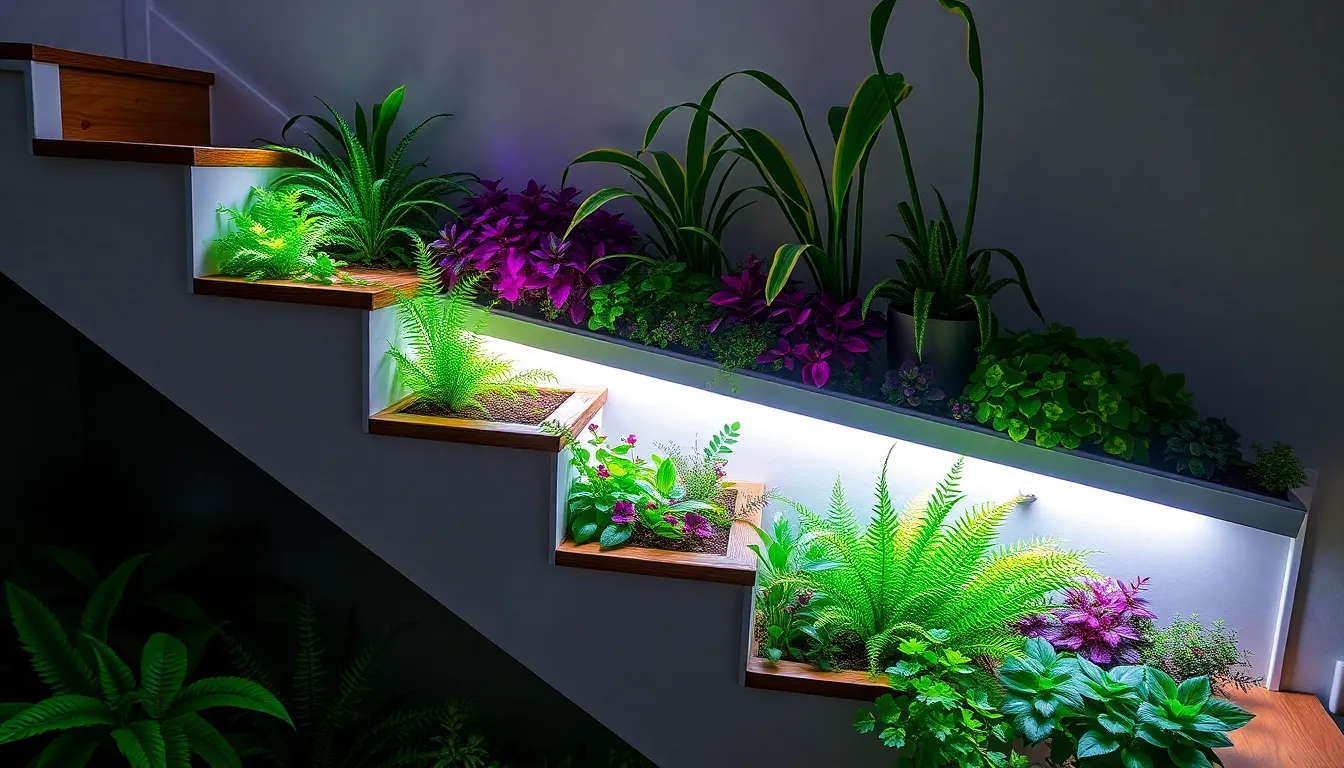
We’ll explore ingenious approaches that transform forgotten spaces and everyday items into thriving garden areas without requiring additional square footage.
Repurposed Household Items as Planters
Wheelbarrow gardens offer mobility and charm for small space gardening enthusiasts. Transform old wheelbarrows into portable growing stations by drilling drainage holes in the bottom and filling them with quality potting soil. Position these mobile planters in sunny spots during growing seasons, then move them to protected areas during harsh weather.
Kitchen colanders provide excellent drainage answers for herb cultivation and flowering plants. Choose colanders with multiple holes to ensure proper water flow, preventing root rot that commonly affects container plants. Place these functional planters on patios or windowsills where herbs like basil, cilantro, and parsley can thrive.
Terra cotta pot towers maximize vertical growing space while creating stunning visual displays. Stack pots of decreasing sizes to showcase multi colored flowers such as petunias, marigolds, and impatiens. This tiered approach saves valuable ground space while delivering impressive height and color variation.
Under-Stair Garden Installations
Compact plant selections work perfectly in these typically underutilized areas beneath staircases. Choose shade tolerant varieties like hostas, ferns, and begonias that flourish in low light conditions. Install shallow planters that fit the sloped ceiling configuration without interfering with foot traffic.
Vertical planter systems transform narrow under stair spaces into productive growing areas. Mount wall planters at different heights to accommodate the staircase angle, creating a cascading garden effect. Incorporate trailing plants such as pothos, ivy, and string of pearls to soften harsh architectural lines.
LED lighting answers enable year round growing in these naturally darker spaces. Install energy efficient grow lights that provide necessary light spectrums for plant photosynthesis. Position lights strategically to illuminate multiple planting levels without creating safety hazards.
Magnetic Planters for Metal Surfaces
Magnetic mounting systems attach securely to railings, fences, and metal structures without permanent installation. These versatile planters work exceptionally well for renters who cannot modify their living spaces. Choose strong neodymium magnets that support plant weight plus soil and water.
Small herb collections thrive in magnetic planters positioned on balcony railings or metal patio furniture. Grow culinary favorites like oregano, thyme, and chives in compact magnetic containers. This approach keeps herbs within easy reach while freeing up valuable surface space.
Succulent displays create low maintenance magnetic gardens perfect for busy gardeners. Select drought tolerant varieties such as echeveria, jade plants, and air plants that require minimal watering. Position magnetic planters at eye level on metal surfaces to showcase unique plant shapes and textures.
Compact Plant Varieties Perfect for Small Gardens
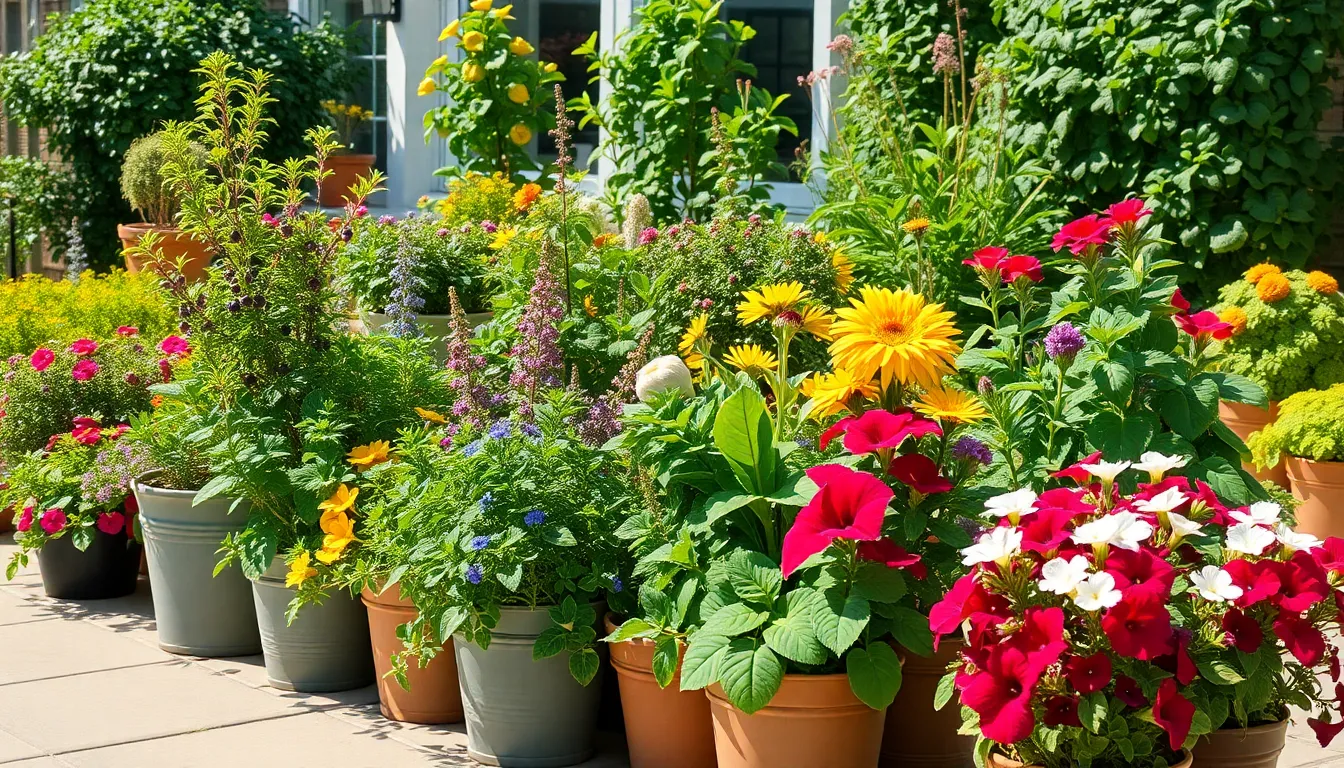
Choosing the right plants transforms even the tiniest garden into a productive oasis. We’ve discovered that selecting compact varieties maximizes yield while minimizing space requirements, creating stunning gardens that thrive in limited areas.
Dwarf Fruit Trees and Bushes
Dwarf apple trees offer the perfect solution for fresh fruit production in compact spaces. These trees reach only 10 feet tall, making them ideal for small gardens where traditional fruit trees would overwhelm the area. Container growing works exceptionally well with these varieties, allowing us to move them seasonally for optimal sun exposure.
Dwarf cherry trees require minimal space while delivering abundant harvests. Container cultivation suits these trees perfectly, making them excellent choices for patios and balconies. Sweet varieties like ‘Stella’ and tart options like ‘Romeo’ provide diverse flavors in remarkably small footprints.
Blueberry bushes thrive in compact garden settings with varieties specifically bred for small spaces. ‘Tophat’ grows to just 2 feet tall while producing full-sized berries, and ‘Bluecrop’ offers exceptional flavor in a manageable 4-foot height. Both varieties adapt well to container growing and provide beautiful seasonal foliage changes.
Miniature Vegetable Cultivars
Cherry tomatoes deliver impressive yields from compact plants perfectly suited for small gardens. ‘Patio’ varieties grow in containers as small as 5 gallons, while ‘Tiny Tim’ reaches only 12 inches tall yet produces dozens of flavorful fruits. These varieties eliminate the need for extensive staking systems typical of larger tomato plants.
Leaf lettuce provides continuous harvests from shallow growing beds ideal for small spaces. ‘Red Leaf’ and ‘Green Leaf’ varieties mature in just 45 days and can be succession planted every two weeks. Cut-and-come-again harvesting extends production throughout the growing season from the same plants.
Radishes maximize space efficiency by growing quickly between other vegetables. French Breakfast radishes mature in 21 days, while Cherry Belle varieties add color and crunch in just 25 days. Interplanting radishes with slower-growing vegetables like carrots optimizes garden space utilization.
Space-Saving Flowering Plants
Petunias create spectacular displays while adapting perfectly to small garden constraints. Wave petunias spread 3-4 feet wide in hanging baskets, creating cascading color walls without requiring ground space. Grandiflora varieties like ‘Ultra’ series provide large blooms in compact containers.
Geraniums offer versatility and long-lasting color in compact growing situations. ‘Martha Washington’ varieties produce showy blooms in containers just 6-8 inches wide, while ivy geraniums trail beautifully from hanging planters. These plants tolerate various light conditions and require minimal maintenance.
Creeping thyme serves dual purposes as groundcover and culinary herb in small gardens. This low-growing plant spreads naturally between stepping stones and requires minimal soil depth. Woolly thyme and mother-of-thyme varieties create fragrant carpets that release pleasant scents when walked upon.
Seasonal Rotation Strategies for Year-Round Growing
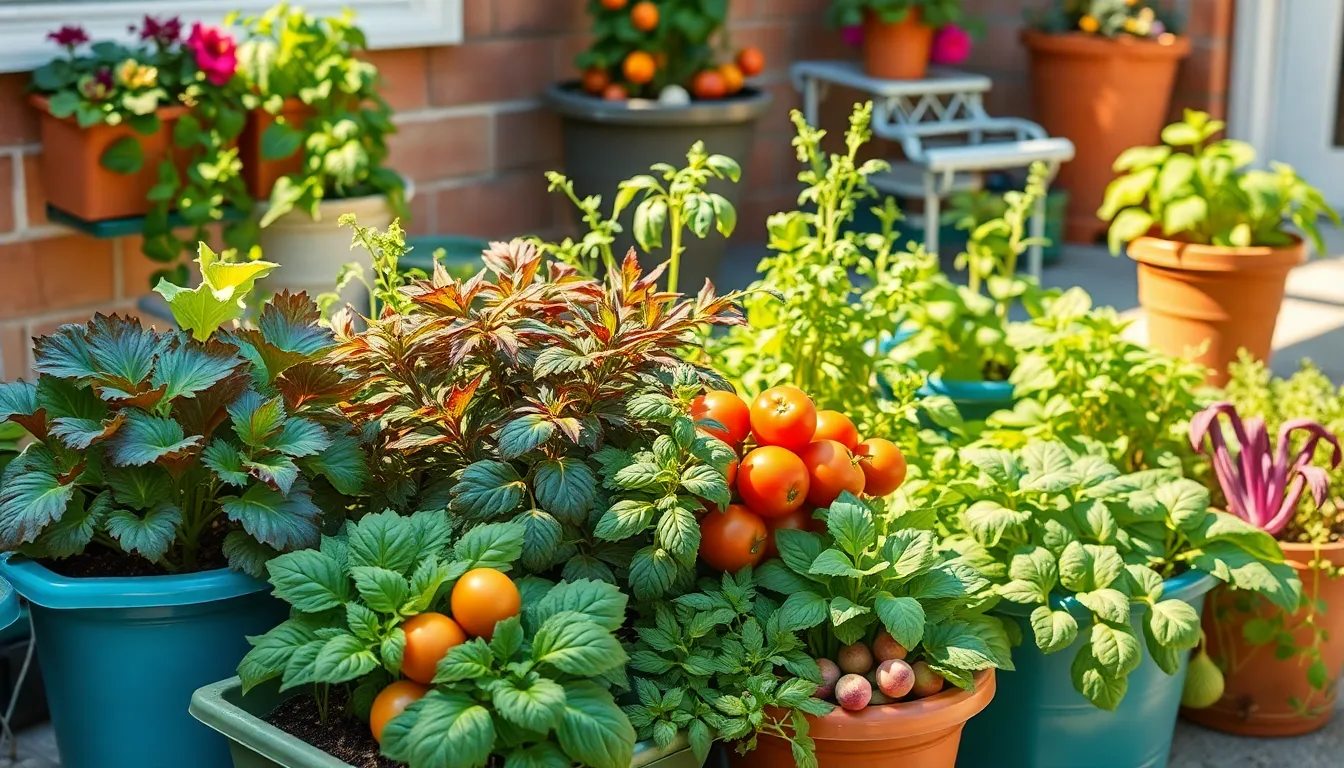
Maximizing our small garden’s productivity requires strategic timing and smart transitions throughout the seasons. We can achieve continuous harvests by coordinating plant schedules and adapting to changing weather conditions.
Spring and Summer Plant Schedules
Cool season crops like lettuce and spinach provide the foundation for our early spring garden. We plant these hardy vegetables when soil temperatures reach 40-50°F, typically 2-4 weeks before the last frost date. Radishes and peas join this early rotation since they tolerate cool conditions and mature quickly.
Warm season vegetables like tomatoes and peppers take center stage as temperatures consistently stay above 60°F. We transition our planting focus around late May or early June, depending on our location. Cherry tomatoes work exceptionally well in containers and can produce 10-15 pounds per plant throughout the summer season.
Strategic timing creates seamless transitions between cool and warm season crops. We harvest early lettuce just as tomato seedlings need their permanent containers, maximizing space efficiency throughout the growing season.
Fall and Winter Indoor Transitions
Moving plants indoors during colder months extends our growing season significantly. We relocate container herbs like basil and parsley to sunny windowsills when nighttime temperatures drop below 50°F. Most herbs continue producing fresh leaves indoors for 3-4 additional months.
Cold frames offer another transition strategy for extending outdoor growing periods. We construct simple cold frames using old windows or clear plastic sheeting to protect crops like kale and Brussels sprouts. These structures can extend the harvest season by 6-8 weeks in most climates.
Indoor growing setups become essential during winter months in northern regions. We position LED grow lights 12-18 inches above leafy greens and herbs to maintain healthy growth throughout the dormant season.
Succession Planting in Limited Space
Succession planting involves planting small batches of the same crop every few weeks to ensure continuous harvest. We plant lettuce seeds every 2-3 weeks from early spring through fall, creating a steady supply of fresh greens. This method works particularly well in small gardens where space limitations prevent large plantings.
Small batch plantings of radishes every 10 days provide consistent harvests without overwhelming our limited storage capacity. We typically plant 6-8 radish seeds per succession, which produces enough for weekly salads without waste.
Compact crops like baby carrots and green onions respond exceptionally well to succession techniques. We dedicate exact container sections to these quick growing vegetables, replanting immediately after harvest to maintain continuous production throughout the growing season.
Budget-Friendly DIY Garden Projects
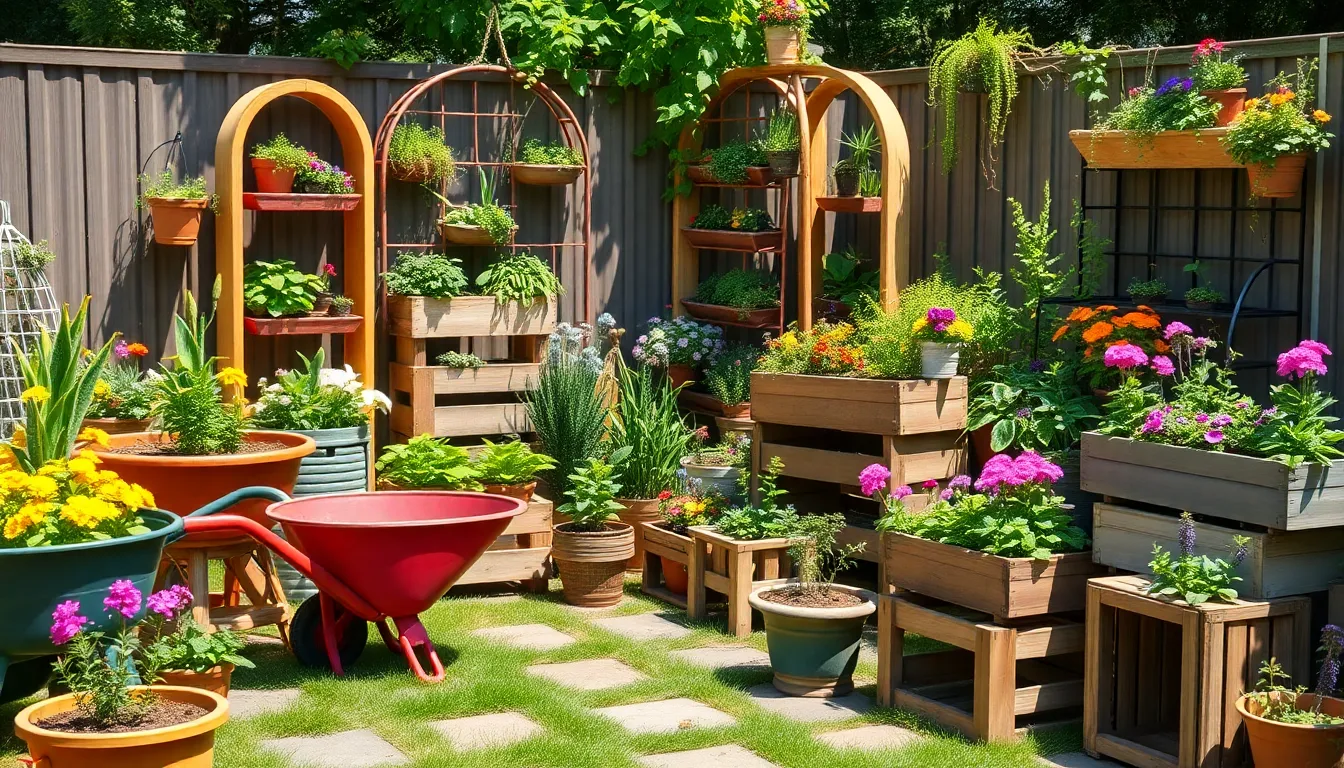
Creating a thriving small space garden doesn’t require very costly. We’ll explore cost-effective answers that transform ordinary materials into productive garden features.
Upcycled Container Ideas
Wheelbarrows make excellent mobile planters that we can move to follow sunlight throughout the day. Simply drill drainage holes in the bottom and add a layer of gravel before filling with potting soil.
Old dressers transform into stunning tiered planters when we remove the drawers and line each compartment with industry fabric. These repurposed pieces create multiple growing zones while adding vintage charm to our garden space.
Vinyl gutters mounted on walls or fences provide perfect growing space for shallow-rooted plants like lettuce and herbs. We can install these horizontally at different heights to maximize our vertical growing area.
Plastic bottles cut in half become individual planters for starting seedlings or growing small herbs. Large soda bottles work particularly well when we cut holes near the bottom for drainage.
Wooden crates stacked or arranged side by side create rustic planter boxes perfect for vegetables and flowers. We can line them with industry fabric to protect the wood while maintaining proper drainage.
Old tires painted in bright colors make durable planters that withstand weather extremes. Stack multiple tires to create tower gardens that maximize our growing space vertically.
Homemade Vertical Garden Structures
Arched trellises built from PVC pipe or bent rebar create stunning focal points while supporting climbing plants like beans and cucumbers. These structures require minimal ground space while dramatically increasing our growing capacity.
Espaliered fruit trees trained against fences using galvanized wire and eye hooks save space while increasing fruit production. We can grow apple, pear, or cherry trees in areas just 12 inches wide using this technique.
Ladder planters made from old wooden ladders provide multiple shelves for potted plants. Position these against walls or fences to create instant vertical gardens that accommodate dozens of containers.
Hanging gardens suspended from pergolas or strong tree branches use overhead space effectively. We can create these using macrame hangers, rope, or repurposed materials like old colanders.
Living walls constructed from wooden pallets lined with industry fabric hold multiple plants in small spaces. These vertical structures can accommodate 20 or more plants in just 4 square feet of ground space.
Cost-Effective Soil and Supply Alternatives
Homemade compost created from kitchen scraps and yard waste reduces our soil amendment costs by up to 75%. We can produce nutrient-rich compost in just 3-4 months using a simple bin system.
Locally sourced mulch collected from tree trimming services or municipal leaf collection programs provides free ground cover. This organic matter suppresses weeds and retains moisture while decomposing into valuable soil nutrients.
Painted rock markers replace expensive plant labels when we decorate smooth stones with plant names. These weatherproof markers cost pennies compared to commercial alternatives and add decorative elements to our garden.
Rain water collection using repurposed barrels or containers reduces our watering costs significantly. A simple 55-gallon barrel can collect over 300 gallons of water from a modest roof area during average rainfall.
Seed starting trays made from egg cartons or yogurt containers eliminate the need for commercial seed starting supplies. We can start dozens of plants using these free materials found in most households.
Conclusion
Small space gardening opens endless possibilities for creating thriving green spaces regardless of your living situation. We’ve shown you that limited square footage doesn’t mean limited growing potential when you apply the right techniques and strategies.
From vertical systems that triple your growing capacity to hydroponic setups that accelerate plant growth these methods transform even the tiniest spaces into productive gardens. Whether you’re working with a balcony windowsill or indoor corner there’s always a solution that fits your exact needs.
The key lies in smart planning strategic plant selection and creative use of available space. With succession planting seasonal rotation and budget-friendly DIY projects you’ll maintain a continuous harvest throughout the year without very costly.
Start small experiment with different techniques and watch your compact garden flourish into something truly remarkable.
Frequently Asked Questions
What is small space gardening and why is it becoming popular?
Small space gardening involves creating lush gardens in limited areas like balconies, windowsills, or small backyards. It’s gaining popularity as more people live in urban environments with minimal outdoor space. This gardening approach allows urban residents to grow fresh produce and beautiful plants using creative techniques like vertical systems and container arrangements, maximizing every inch of available space.
How can vertical gardening triple my growing capacity?
Vertical gardening allows plants to grow upward instead of outward, effectively using the same ground footprint to accommodate three times more plants. Solutions include living wall systems, trellises, DIY pocket gardens, hanging planters, and tower gardens. These techniques not only maximize space but also create visually appealing green walls that enhance both productivity and aesthetics.
What containers work best for small space gardening?
Choose containers with proper drainage holes and appropriate sizes for your plants’ root systems. Materials like ceramic, plastic, and fabric pots each offer unique benefits. Multi-level container arrangements and companion planting strategies help optimize space further. Consider self-watering planters for convenience and ensure containers match your plants’ specific needs for optimal growth and health.
Can I grow food indoors without a garden?
Yes! Indoor micro-garden systems include countertop herb gardens, hydroponic systems, and LED grow light setups. Hydroponic systems eliminate soil mess while accelerating growth rates. LED grow lights provide necessary light spectrums for plants to thrive indoors year-round. Automated systems with timers make indoor gardening beginner-friendly and perfect for apartments with limited outdoor access.
What are the best compact plants for small gardens?
Dwarf fruit trees like compact apple and cherry varieties thrive in containers and can be moved seasonally. Miniature vegetables such as cherry tomatoes, leaf lettuce, and baby carrots offer impressive yields in small spaces. Space-saving flowering plants like petunias and geraniums adapt well to container constraints while providing beautiful color and fragrance.
How do I keep my small garden productive year-round?
Use seasonal rotation strategies by transitioning between cool-season crops (lettuce, spinach) and warm-season vegetables (tomatoes, peppers). Extend growing seasons by moving plants indoors during winter and using cold frames. Succession planting involves planting small batches at intervals to ensure continuous harvests without overwhelming your limited space or storage capacity.
What are some budget-friendly DIY garden projects?
Transform everyday items into planters using wheelbarrows, old dressers, or kitchen colanders. Create homemade vertical garden structures and terra cotta pot towers. Build cost-effective soil alternatives through homemade composting and set up rainwater collection systems. Magnetic planters work great for metal surfaces and are perfect for renters seeking versatile, moveable solutions.
How do I maximize forgotten spaces in my home for gardening?
Utilize under-stair areas with compact plant selections that thrive in lower light conditions. Transform corners with multi-level arrangements and privacy screens using climbing plants. Repurpose household items creatively and consider magnetic planters for refrigerators or metal surfaces. These forgotten spaces can become productive micro-gardens with thoughtful planning and creative container solutions.

